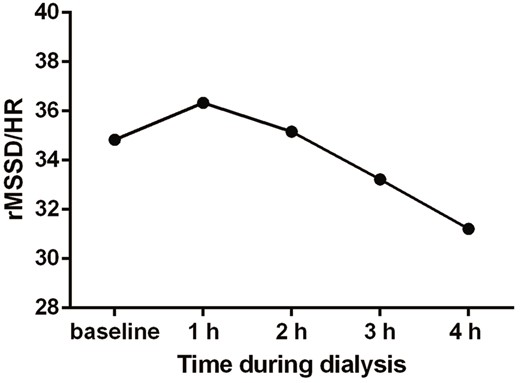-
PDF
- Split View
-
Views
-
Cite
Cite
Clare Tomlinson, Matthew Graham-Brown, Darren Churchward, Ben Stockdale, Simon Dickinson, Anna-Marie Marsh, Alysha Careless, Daniel March, James Burton, SP564
AEROBIC INTRADILAYTIC EXERCISE: AN EFFECTIVE APPROACH TO IMPROVE HEART RATE VARIABILITY?, Nephrology Dialysis Transplantation, Volume 32, Issue suppl_3, May 2017, Page iii324, https://doi.org/10.1093/ndt/gfx152.SP564Close - Share Icon Share
INTRODUCTION AND AIMS: Haemodialysis (HD) patients have been shown to have lower heart rate variability (HRV) compared to healthy controls; an independent risk factor for cardiac mortality. This is thought to be due a number of factors including uraemia and diabetic neuropathy. The effect of HD on HRV in the intradialytic period is unclear with no data on whether it can be improved by regular aerobic intradialytic exercise. The aim of this study was to investigate changes in HRV during the intradialytic period and the effect of 6 months of regular intradialytic exercise on baseline HRV.
METHODS: Forty-eight hour Holter monitoring was performed on 18 HD patients for time domain HRV calculation using Cardiscope™ (HASIBA Medican GmBH supplied by SMART medical). Baseline HRV data was obtained as a 4 hour (h) average on a non-HD day. This was compared to the average for every 1 h period during the 4 h of HD. Six patients who undertook intradialytic exercise as part of the CYCLE-HD study (ISRCTN: 11299707) then underwent repeat Holter monitoring six months later and a second HRV 4 h average (6M) on a non-HD day was obtained. HRV was expressed as the root mean square of successive interval differences (rMSSD) over heart rate to give an individually calibrated measure. Data was assumed to be normally distributed. HRV was compared over the duration of HD using a repeated measures one-way ANOVA. Unpaired t-tests were used to compare the effect of a six month programme of intradialytic exercise on HRV. Statistical significance was accepted at P < 0.05 level.
RESULTS: There was an increase in HRV from baseline to the first 1 h of HD (BASE 34.83 ± 40.90; 1h 36.33 ± 41.21). Over the following 3 h of HD, there was a trend suggesting a consistent decline in mean HRV (2 h 35.17 ± 36.16; 3 h 33.22 ± 36.18; 4 h 31.22 ± 32.96; P=ns, see figure). After 6 months of regular intradialytic exercise, there was a trend towards improved HRV compared to baseline (BASE 36.35 ± 41.63; 6M 68.67 ± 44.17; p=0.09).

SP564 Figure





Comments